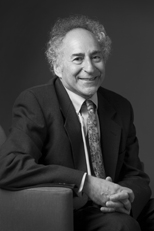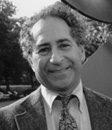Central Europe in June: Journey into History
" Central Europe in June: Journey into History By Daniel R. Schwarz", July 11 2017,
http://www.huffingtonpost.com/entry/595f720fe4b085e766b511b4
Introduction
It has been some years since my wife, Marcia Jacobson and I have been in Germany and even longer since we have been in Prague and Vienna. One of the pleasures of this trip was our return to major cities that we visited in the past: Berlin, Dresden, Prague, and Vienna. Visiting cities with memories of one or two past visits is a very different from returning to places that we know well— in our case, Paris, Rome, London, Florence-and walking familiar streets. In addition to the aforementioned major central European cites, we also visited for the first time Potsdam, Wittenberg, Meissen, and some other places on the Elbe.
A visit to central Europe is a history lesson not only about the Holocaust, World War I and II, the Russian occupation of much of Central Europe, the Cold War, and the end of the Soviet empire but also about European history dating back to the Middle Ages. Not a day goes by in Central Europe when I am not conscious of history. For me history is less about the Hapsburgs and the other royal families and more about the twentieth century.
Berlin
We began our journey in Berlin, a city that has blossomed once again as one of the great cities in Europe since the division of the city into East and West Berlin ended in 1989. Most of the historic district was destroyed in WWII as can be seen in Rosselini's 1948 neo-realistic Germany Year Zero that was filmed in 1947 on location. The centerpiece of this district is the neoclassic Brandenburg Gate, originally built in the eighteenth century. Even a casual observer can see how much of the central city has been rebuilt, often to replicate the original architecture as closely as possible. But some of the reconstruction in both the former West Berlin and even more so the former East Berlin feature non-descript and coldly functional Soviet style architecture with small windows and bland grey exteriors.
Because most of the historic district known as the Mitte (or "middle") area was in East Berlin, we chose to stay at the Westin Grand in that area because it is not only without shopping malls, but it is also close to Museum Island which contains the Pergamon Museum(Islamic and classical art); the Bode-Museum(sculpture), the Neues Muesum(archeology and the famous Nefertiti statue), the Alte Nationalgalerie (mostly German Neoclassic and Romantic painting), and the Atles Museum(antiquities). Indeed, I recommend spending a full day on Museum Island. The historic district is close to other major attractions, including Checkpoint Charlie--the best know crossing point in West Berlin after the Berlin Wall was constructed) -- and the Jewish sites described below.
Jewish Berlin
As someone whose family emigrated from Germany, albeit in the nineteenth century, and who has written a book on Holocaust books and films (Imagining the Holocaust), Jewish Berlin has special meaning for me.
Designed by Peter Eisenman, the Holocaust Memorial, one block South of the Brandenburg Gate, where the Wall divided the city. The Holocaust Memorial's 271 stark concrete blocks stand in contrast to its underground museum's moving history of genocide, tragedy, and loss.
 |
Holocaust Memorial in Berlin |
Equally moving is the Jewish Museum with its history of German Jewery from the middle ages through the Holocaust. The Jewish Museum has an architectural structure that points up the fate of German Jews even while containing detailed in-depth presentations of paradigmatic Jewish figures in every historic period.
Quite touching are the thousands of small brass memorials on the street; they designate the residences and shops where Jews and other Holocaust victims such as gypsies and homosexuals lived and worked. Called Stolpersteine("stumbling stones"), they are also placed elsewhere in Germany and Europe and are part of an ongoing project initiated by artist Gunter Demnig in 1992.
Other Berlin Highlights
I very much recommend the Gemaldegalerie (take a bus to Matthäikirchplatz) which features European painting through the eighteenth century, and has quite a few major works beginning with Giotto and Vander Weyden and includes two Vermeers (one of which was on loan), two Caravaggios, many Rembrandts, as well as superb Titians and Raphaels. While the good news is that the museum is not crowded even in high tourist season, the bad news is that most of the written material on the wall is only in German. The free audio guide is a must and excellent but only covers, a small fraction of the works in the museum.
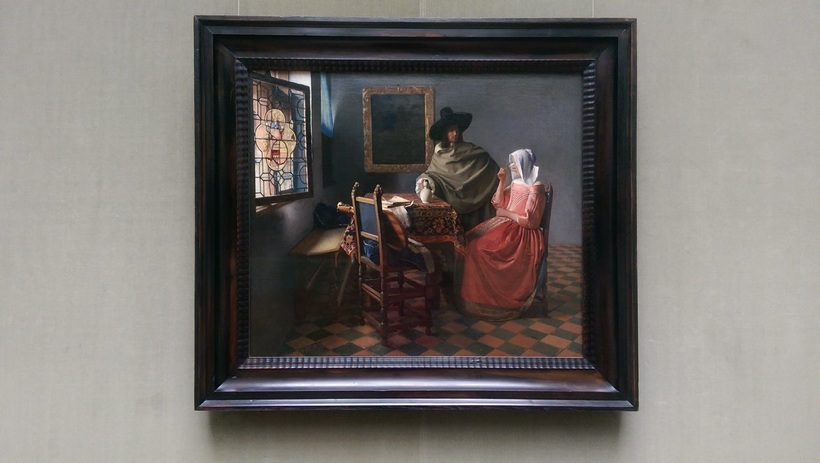 |
Vermeer, The Glass of Wine |
Also quite wonderful is Museum Berggruen, with a splendid modern collection featuring Picasso and Klee, with major works by other notables, too, including Matisse. Across the street and with same ticket you can visit Sammlung Scharf-Gerstenberg Museum, featuring such Surrealists as Duchamp, Ernst, and Dali, among others.
In its Tiergarten section Berlin also has one of Europe's great zoos and, as part of the Berlin Zoological Garden complex, a fine aquarium. Due to rain we chose the latter and enjoyed the myriad of sea creatures and reptiles.
Viking Tour and Cruise
On our fourth day we joined a nine-night ten-day Viking tour, which began with two nights at the Intercontinental Hotel, although there were optional pre-tour days at the hotel for those who wished to come to Berlin within the tour structure. Viking also offered a post trip excursion to Cracow and Warsaw.
Most of these last two Berlin days we chose to be on our own, but we did do a Berlin by Night optional tour ($99 each). The mediocre dinner at Georgbrau Brauhaus(Spreeufer 4l 10178) featuring bone dry wiener schnitzel and mountains of boiled potatoes reminded us that optional group tour meals are often mediocre, but for those who have not been to Berlin, the tour had some merit.
On the third day of the Viking component of our trip, we began a journey through the old East Germany. On our bus to the Viking Beyla, which awaited us at Wittenberg, we stopped for a visit to Potsdam where two major twentieth century conferences took place. The first was the Wansee Conference in January, 1942 at which the Final Solution for eradication of all Jews was endorsed; the second was 1945 Potsdam Conference to discuss Post-War Germany. We then stopped at Wörlitz Park where we explored a castle and took a pleasant and relaxing gondola ride on the little lake.
We spent the first full day of our river tour exploring Wittenberg, a quaint if touristy university town of about 50,000. Our Viking Wittenberg tour day was an informal seminar on Martin Luther and his time. According to legend . Martin Luther's nailed his Ninety-Five Theses against the selling of indulgences on the door of the All Saints' Church, an event considered the beginning of the Protestant Reformation. In fact, Luther did protest the selling of indulgences, but did so in a letter to superiors containing the Ninety-Five Theses. We visited sites connected with Lucas Cranach the Elder who lived in Wittenberg and painted portraits of his friend Luther as well as biblical scenes. Our guide never mentioned Luther's anti-Semitism, which certainly is one of the seeds of Nazi ideology; I did hear that at least one of the other tour guides hired by Viking did.
Our next stop was Meissen, famous for its porcelain. I found the visit to the Meissen factory interesting and enjoyed looking at their museum containing elegant Meissen-ware treasures over the centuries. In Meissen I also recommend the splendid Gothic (now Lutheran) Cathedral, dating to the thirteenth century.
 |
Meissen Museum |
Severely bombed by the allies at the end of World War II, culturally isolated during the Soviet domination of East Germany, and the victim of a serious flood within the last few years, Dresden has had its share of twentieth century traumas. Despite the bombing, the old master art collection at the Zwinger palace complex was preserved. Do not miss The Sistine Raphael and Vermeer’s Procuress. Another wonderful site is the rebuilt baroque Dresden Opera House; on a prior visit we went to the ballet there. The restored Lutheran Frauenkirche is also a must.
 |
Dresden Opera House |
On the Elbe, the scenery between Dresden and Prague was the most striking, particularly in the area of Germany called Saxon Switzerland. We stopped at Bad Schandau near the Czech border but still in Germany and drove to an extraordinarily scenic rock formation known as the Bastei, where we walked for a few hours.
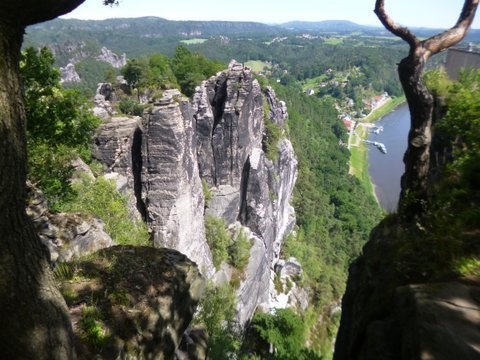 |
The Bastei |
After five nights on the boat, we left the cruise ship and were bussed to Prague. Prague is teeming with tourists and has become something of Europe's Disneyland, with the Charles Bridge feeling like Times Square or Hong Kong. In Old Town we saw the remarkable Astronomical Clock dating back to 1410.
 |
Statue of Kafka in Prague |
While Catholicism has mostly lapsed in the Czech Republic, due in part to the post WW II decades of Soviet domination, you can find striking churches on every block of the older parts of Prague. After crossing the Charles Bridge, we came across two ornate Catholic baroque churches, St. Joseph and St. Thomas.
Billed as the largest castle in the world at 750,000 square feet, the Prague Castle complex dates from the ninth century and serves as official resident of the Czech President. It contains St.Vitus cathedral, a stunning Gothic structure that should not be missed.
The complex also contains Lobkowicz Castle which we visited on an expensive optional Viking tour. Offering great views of the city, the castle has a museum which has a medley of treasures but few major paintings except for Peter Breughel the Elder's Haymaking. The included lunch was not only disappointing but served by surly staff. The short classical concert was fine but only about 20 minutes long. Whether on a tour or alone, if you have only a few days, I recommend passing on Lobkowicz Castle and spending time at the Prague National Gallery as we did on our prior visit.
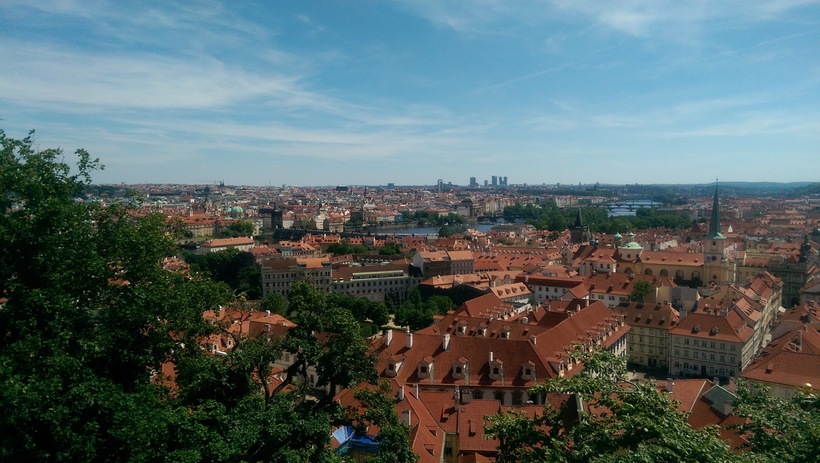 |
Prague from Lobkowicz Castle |
Viking's optional tour of the Prague Jewish District was exceptionally well done and a model of what an educational tour should be. Our guide was knowledgeable and informative.
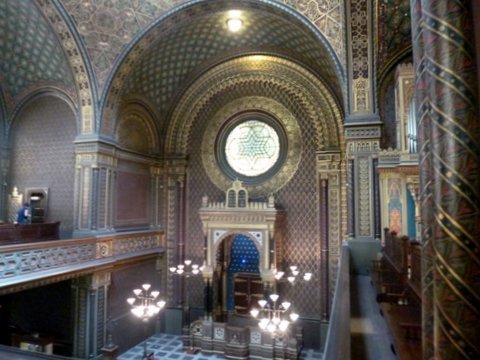 |
Spanish Synagogue in Prague |
Vienna
After the Viking component of our trip ended, we took a pleasant four hour train ride to Vienna where we stayed four nights. To get your bearings in Vienna, you might head first for St. Stephen's Cathedral in the busy and touristy historic district. This marvelous Romanesque and Gothic structure stands on ruins of a church consecrated in 1147 and again in 1263.
When I think of what I love about Vienna five things come to mind:
1) The Kunsthistorisiches Museum, one of central Europe's stellar art museums with its Titians and Rubens and, especially, Vermeer's The Artist's Studio; the museum faces the fine Natural History Museum, which has a similar exterior structure.
2) The historic Opera House, located on the Ringstrasse which circles the historic district. We had been to an opera on a past visit, and I recommend getting tickets in advance which, alas, we failed to do this time.
3) The Albertina(adjacent to the Opera House) featuring an exhibition ("From Monet to Picasso") of the permanently loaned Batliner collection, with terrific mini essays on the walls describing the various schools of modern art. The Albertina also houses a world class print and drawing collection.
4) The Belvedere Palace Museum, featuring Klimt and Schiele as well as lovely gardens, and the nearby "21er Haus," a contemporary museum which can be visited on the same ticket with a small supplement.
5) Memorable desserts.
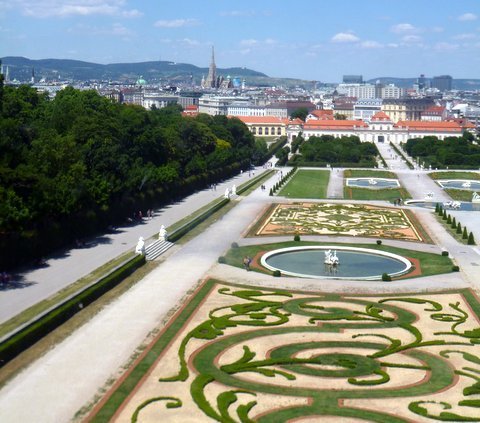 |
View of Belvedere Gardens and Vienna |
The Cruising Experience: Five Nights on the Elbe
Viking offers a strong product for those who want every detail taken care of and their cruises are especially convenient for those with infirmities. For the most part each day was well planned, especially on the Elbe. Because of the shallowness of the Elbe, Viking uses a boat carrying about 96 passengers rather than the larger ones that they use on the Danube and some other river cruises. Our cabin was on the higher of the two passenger decks; we had a private balcony, which we used on occasion for quiet time and reading, and a full window. While there is no exercise room, I did enjoy walking on the deck (10 loops to a mile) which I found as a way to enjoy the scenery. I do think one cabin might be turned into a small fitness room.
I particularly enjoyed the stops (Wittenberg, Meissen, Dresden, Bad Schandau) which were much better than our prior Viking trip from Bucharest to Budapest on which we had a few stops which I found negligible. The balance between the ship days and the land days-two days land at the beginning (Berlin) and two days at the end (Prague)-worked well. The enthusiastic cruise director was a plus. The classical concert on board was a highlight, and I enjoyed hearing both the woman who spoke about life in East Germany before the Berlin Wall fell and the lively discussion that ensued.
I liked the division into groups that wanted more walking and those who did not or could not walk much. There was much less of that on my prior Viking cruise. If you are mobile you can break away from the group and explore on your own, as long as you return to the boat by departure time. On land days, we made our way back to our hotel when we wished.
On the boat, you have the option of eating informal meals on deck or eating in the dining room. Meals are not as elegant as on upscale cruise ships, but they are quite good if relatively simple. Dinners include three basic courses: appetizer, main course, deserts. On a few nights, we asked for an accompanying salad. Portions are ample but not large. I found the quality of meat to be a highlight and the soups disappointing, I would have liked more fresh berries at breakfast and as a dinner desert. On a prior Viking cruise, we had fresh squeezed juice but this was not possible on this one, although we asked. On request I was able to get crepes for breakfast. In terms of food you need to understand that this is not a cruise ship with a huge kitchen and many chefs, but then again the smallness of the ship and the small number of fellow passengers are attractions.
At dinner, I felt that the kitchen and/or waiters might have been understaffed. One night we waited 45 minutes between the first course and entrée, and on another occasion it took quite a while for a waiter to arrive to take our order. My suggestion would be rolling dinners with three groups beginning fifteen minutes apart, something many restaurants do.
Tipping: Rather than recommend exorbitant tipping ($12 a person per day plus tips for the cruise director as well as every guide and bus driver), I strongly urge Viking to offer the all-inclusive tours that are becoming more common. The truth is that experienced travellers are tired of these tipping demands. While some guests resent it, others, particularly those from not tipping countries, ignore it. The whole tipping experience somewhat sours the journey for many.
Hotels
All too often I find that to get first-rate service at hotels, you have to make your expectations clear. Particularly in Europe, be wary of the first room you are offered unless you are a regular guest of a chain and have a platinum or comparable designation. Be aware that among five-star hotels there is a huge difference between a high end luxury Four Seasons or Ritz-Carleton and a big hotel hosting tours and conferences.
Berlin
At first the well-located Westin Grand (Friedrichstrasse 158-164) in the historic district didn't seem quite as polished or well-staffed as we expected, but after a conversation with management, it improved dramatically and I still recommend it. Breakfasts were the most sumptuous of our trip, with fresh squeezed orange juice (on request), crepes, various herrings, and a fine assortment of breads.
After joining the Viking trip, our first room in the Intercontinental, the hotel chosen by Viking and located near the zoo and aquarium but also in a mall area, was disappointingly small with a broken shower. On our request to the hotel we were moved to a nice room in the new wing. The hotel's huge lobby is a cold, impersonal, and a waste of space.
Viking has contracts with large hotels because they have as many as 500 guests on various trips. Their contracts call for the least expensive rooms, but with a little effort, working not through Viking but the hotel, you can usually get an upgrade without charge.
Prague
Not to be confused with the better located Hilton Prague Old Town, the Hilton Prague is located a long walk from the historic district and is another large impersonal hotel. I would rate this hotel a four-star rather than the five stars it claims, and would not stay there if we were to return to Prague on our own, For one thing, the hotel offers a somewhat disappointingly impersonal buffet breakfast. For another, during our visit the lobby had been turned over to a business conference and was filled with advertising kiosks.Vienna
Taking its name from its past function, the Imperial Riding School Renaissance, is a four -tar hotel in two buildings; we stayed in the newer one. The breakfast was satisfactory and eating outside in the garden was a pleasure. The air-conditioning is deficient and the staff doesn't readily answer the service phone. The hotel offers a nice fitness center with an indoor pool, but we got our exercise in the considerable walk to the historic area. For those wishing a more centrally located and elegant hotel on the Ringstrasse, try the more expensive and elegant Bristol.
Restaurants
Berlin
Brasserie an Gendarmenmarkt, Taubenstr, 30, is an excellent value and serves delicious food. We were there during the white asparagus harvest, and began our dinner with asparagus soup, followed by asparagus risotto, followed by asparagus and salmon terrine. Every course was nicely presented. No, we didn't have asparagus sorbet for dessert but rather raspberry and peach sorbet.
Continuing our courtship with white asparagus, we enjoyed a festive dinner at the Relish Restaurant in the Westin Grand with a fine dover sole, traditional steak fillet, and, of course, the essential white asparagus soup plus a generous portion of white asparagus.
Bocco di Bacco, Friedrichstrasse 157 serves dependably tasty Italian cuisine that is professionally served in a pleasant setting. We had bread-tomato soup, ravioli with ricotta, fusilli with tomatoes and asparagus (with less of the latter than I expected), and crème brulee. Service is good, but the food was not quite as polished as I remembered it from our visit in 2004.
Prague
Ornately Art Nouveau, Plzenska is a beer hall and restaurant in Municipal House at edge of Old Town; we had potato pancakes and a large salad with sliced chicken; with tip about $20. There is an upscale French restaurant upstairs.
Perhaps the Imperial Hotel is worth a visit for the Art Deco dining room, but be aware that this establishment adds on extra little charges and you can eat better and less expensively elsewhere. We were served lamb shank instead of our ordered rack of lamb; after they acknowledged their mistake we received fatty chops. Served with huge dumplings-an example of heavy Czech food—the confit of duck was overcooked and the strudel was soggy.
Vienna
Our best meal in Vienna was at Huber's Essen und Trinken (Rennweg 11). The owner's wife is an excellent cook of simple food with fresh ingredients; her husband serves a small number of tables, most of which are outdoors in the summer. While my wife had delicious trout, I had satisfying cannelloni with tomato and asparagus sauce. The delicious desert crepes were among the most memorable dishes on our trip. A cover charge includes bread, olives, and even a small cup of soup, and thankfully avoids the unpleasantness of small charges for tap water, ice, and butter that we experienced on occasion in Prague and Vienna.
I would consider the informal overpriced meal at the historic elegant Sacher Hotel more a fun tourist event than a culinary experience. Served without any accompaniment the sausage course not only looked liked two good-size hot dogs but didn't taste much different, despite the beautiful serving bowl and traditionally dressed waiter. The croissant sandwich was decent but hardly breath-taking .But the Sacher Torte was wonderful. You may have to stand on line to get seats. I would recommend waiting for the elaborate rooms inside rather than sitting on the outside terrace.
Serving respectable food at a fair price for an hotel, Arsenal at the above mentioned Renaissance hotel advertises itself as an "authentic Viennese Heurigen"-basically a tavern. The trout and the asparagus risotto were quite tasty and the Sacher Torte, while not up to the one at the Sacher Hotel, was excellent.
Avoid at all costs Winkler's Zum Posthorn, located near our hotel; the terrible food is complemented by an unpleasant owner who padded our bill. He charged us three separate times for filling our glasses with tap water and also added a Euro charge for bringing us an extra plate to share food, although we ordered dishes for both of us. Be forewarned that the owner makes clear that he hates those who do not speak German, declares loudly and without provocation that "This is Austria, not New York" and, based on his comments, has a seemingly deep-seated bias about Americans and perhaps Jews.
Author of numerous travel articles as well as seventeen books, including the recently published How to Succeed in College and Beyond; The Art of Learning (Wiley, 2016) and the well-received 2012 book Endtimes? Crises and Turmoil at the New York Times (Excelsior Editions of SUNY Press; 2014, a new paperback edition). Daniel R. Schwarz is Frederic J. Whiton Professor of English and Stephen H. Weiss Presidential Fellow at Cornell University. His prior published travel articles can be found here. He can be reached at drs6@cornell.edu and followed on twitter at www.twitter.com/danRSchwarz or on facebook at https://www.facebook.com/SchwarzEndtimes.
